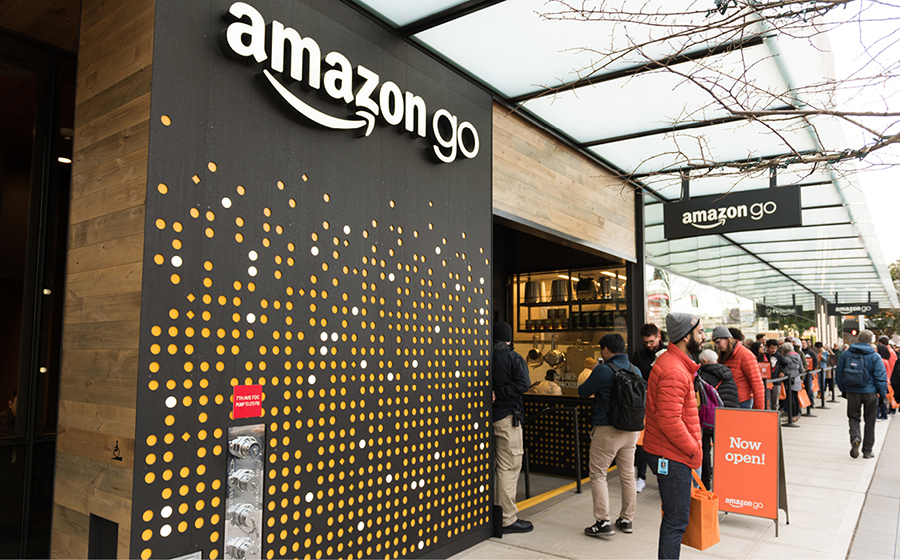The Amazon Go concept is innovative enough that it may prove to be a highly disruptive force. Yet, it might be a little too soon for anyone in established food retailing to despair. Nonetheless, let\’s take a closer look the Amazon Go stores and whether there\’s much chance that thousands of them might really spring up.
As is well known, the Amazon Go stores are brick-and-mortar units, embed with high tech. Their main claim to fame is that they\’re cashier-less. Video and AI detect the products shoppers pull from the shelves; costs are seamlessly applied to customers\’ previously registered credit cards. All this takes place without any active involvement from shoppers. They just select what they want and walk out.
Technology and Entertainment Show
The concept is novel, but who knows if the charm of cashier-less shopping will wear thin after a while? To date, the stores are very small, at less than 2,000 square-feet, and have just few hundred products to offer. They\’re really not fully practical shopping venues.
The reality is that the lines to enter stores are often so long that any time saved by not interacting with a cashier is consumed by the wait. Amazon Go is as much a technology and entertainment show as it is a store.
Only four stores have been opened thus far – three in Seattle and one in Chicago – and they\’re located in office districts. The idea is that office workers can quickly get a pre-packaged sandwich, snack, candy, beverage and the like for lunch or after work. No hot food is offered. A couple of the stores also feature a limited line of grocery staples, some under the Amazon-owned Whole Foods\’ private label.
As for the near future, another store is planned for Chicago, two for San Francisco and one for New York. So, if things move right along there could eight or so of the units by the end of this year, of which six will have been opened this year. At the rate of six per year, it would take 500 years to open 3,000 stores, so the rollout rate would have to increase astronomically. It\’s worth emphasizing that the 3,000-store figure hasn\’t been verified by Amazon and is based on reporting from Bloomberg News.
The big rollout prediction reminds me of Tesco\’s venture in the U.S. Tesco is the major supermarket operator in the UK that several years ago entered the U.S. Southwest with Fresh & Easy stores. In some ways, they were precursors to Amazon Go stores in that they had a mini-market product offering and had only customer-actuated checkouts, making it an earlier version of the Amazon Go cashier-less store. It was also predicted that Fresh & Easy stores would soon span from coast-to-coast by seeding a store into every hamlet in the nation. Instead, the concept never picked up much customer traction; today the entire enterprise is defunct.
What If?
No one is predicting that the Amazon Go concept will fail, especially since Amazon often pulls off what seems implausible.
So, let\’s ask: What would happen to established retailers if Amazon could suddenly pull off the magic of opening maybe 1,000 Amazon Go stores per year to meet the 3,000-store prediction?
That could be in the cards if Amazon\’s Jeff Bezos sees Amazon Go as new technology in the making, as it is today.
He may see it as an experiment to test consumer preferences and willingness to use the cashier-less technology. It\’s a pretty sure bet that Gen Z consumers – those born roughly between the mid-1990s and the early 2000s – will be fast adapters. Amazon Go stores are driven by Smartphone apps, from consumers\’ point of view. That generation was all but born with Smartphones in their hands and tend to think nothing is real unless it has something to do with technology. Since they make up 25 percent of the U.S. population already, they\’re the vocal future.
Let\’s also imagine that Amazon Go stores can be made more practical by making them larger and with additional storekeeping units, say up to about 10,000. That\’s roughly the SKU count of an Aldi store, and Aldi is very successful at the moment and growing rapidly.
If all those conditions materialize, established supermarkets, convenience stores and specialty stores could be under major threat. Major operators such as Walmart and Kroger have already started minor experiments focused on cashier-less technology. Smaller operators have no capacity to do that. The retailing landscape could really change.
But if none of those blue-sky possibilities come about, conventional operators will have little to worry about for a long time to come. Other lines of retailing, such as apparel and home goods, have less to worry about from Amazon Go.
Finally, here\’s another consideration: Amazon Go may be joined by another brick-and-mortar experiment that would be simpler to scale up: Amazon just opened its first \”Amazon 4-Star\” store in New York. It\’s a physical store that features the best-selling products from Amazon online, those earning \”4-star\” status. Included are categories such as games, consumer electronics, kitchenware, books and toys.
Let\’s face it. Amazon is just getting started.




